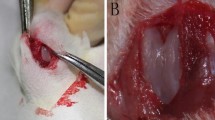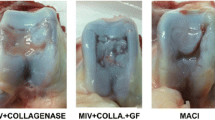Summary
Various experimental models have been used in young rabbits to determine the conditions necessary to induce chondrogenesis in the inner layer of periosteum after injury. Chondrogenesis will always occur in the presence of a haematoma, torn periosteum and bone, but if one of these factors in missing such a response may not necessarily occur.
Résumé
Différents modèles expérimentaux sont réalisés chez le jeune lapin et comparés entre eux de manière à déterminer les conditions nécessaires et suffisantes pour induire une chondrogenèse de réparation au départ de la couche profonde du périoste. Cette chondrogenèse se produit toujours lorsque les trois éléments suivants sont réunis: formation d'un hématome, présence d'os et décollement du périoste. Elle ne se produit pas régulièrement si l'un des trois éléments est manquant.
Similar content being viewed by others
Réferences
Anderson, L. D.: Compression plate fixation and the effect of different types of internal fixation on fracture healing. J. Bone Joint Surg. (Am.) 47 191–208 (1965)
Bassett, C. A. L., Hermann I.: Influence of oxygen concentration and mechanical factors on differentiation of connective tissues in vitro. Nature 190 460 (1961)
Bassett, C. A. L.: Current concepts of Bone formation. J. Bone Joint Surg. (Am.) 44 1217–1244 (1962)
Bassett, C. A. L.: Environmental and cellular factors regulating osteogenesis. In Frost, H. (Ed.): Bone biodynamics, 233–244. Boston: Little Brown 1964.
Bertelsen, A.: Experimental investigations into post-foetal osteogenesis. Acta Orthop. Scand. 15 139–181 (1944)
Bridges, J. B.: Pritchard, J. J.: Bone and cartilage induction in the rabbit. J. Anat. 92 28–38 (1958)
Cavadias, A. X., Trueta, J.: An experimental study of the muscular contribution to the callus of fracture. Surg. Gynec. Obstet. 120 731–747 (1965)
Cohen, J., Lacroix, P.: Bone and cartilage formation by periosteum. J. Bone Joint Surg. (Am.) 37 717–730 (1955)
Coutelier, L.: Recherches sur la guérison des fractures. (Thèse Univ. Louvain) Bruxelles: Arscia Paris: Maloine (1969)
Delamotte: Traîté complet de chirurgie. Paris: Sabatier 1771.
Duhamel, H. L.: Observations sur la réunion des fractures des os. Premier mémoire. Mém. Acad. roy. Sc. 54 97–112 (1741)
Flourens, P.: Recherches sur le développement des os et des dents. Paris: Gide 1842.
Girgis, F. G., Pritchard, J. J.: Experimental production of cartilage during the repair of fractures of the skull vault in rats. J. Bone Joint Surg. (Br.) 40 274–281 (1958)
Ham, A. W.: A histological study of the early phases of bone repair. J. Bone Joint Surg. (Am.) 12 827, (1930)
Ham, A. W.: Some histophysiological problems peculiar to calcified tissues. J. Bone Joint Surg. (Am.) 34 701–728 (1952)
Hellstadius, A.: A study of new bone formation provoked by subperiosteal injections of blood plasma, extract of bone marrow, etc... Acta Chir. Scand. 95 31–53 (1947)
Krompercher, S.: Die Knochenbildung. Jena: Fischer 1937.
Lacroix, P.: Recherches expérimentales sur l'ostéogenèse périostique. Arch. Biol. 57 99–136 (1946)
Lacroix, P.: L'organisation des os. Paris: Masson 1949.
Lacroix, P.: Sur la réparation des fractures. Les mécanismes locaux. C. R. 15è Congrès Soc. Intern. Chir. 553–563 (1953)
Maurer, P., Zucman, J. Lewalle, J.: Rôle de la vascularisation péri-fracturaire et centro-médullaire dans l'ostéogenèse réparatrice. Rev. Chir. Orthop. 51 229–242 (1965)
Mueller, M. E.: A propos de la guérison per primam des fractures. Rev. Chir. Orthop. 50 697–704 (1964)
Olerud, S., Danckwardt-Lillieström, G.: Fracture healing in compression osteosynthesis in the dog. J. Bone Joint Surg. (Br) 50 844–851 (1968)
Rokkanen, P., Slätis, P.: The repair of experimental fractures during long-term anticoagulant treatment. Acta Orthop. Scand. 35 21–38 (1964)
Schenk, R., Willenegger, H.: Morphological findings in primary fracture healing. Symp. Biol. Hung. 7 75–86 (1967)
Scultet: Armamentarium chirurgicum. Ulmae, 1653. Traduit en français en 1672.
Urist, M. R., Mc Lean, F. C.: Osteogenetic potency and new bone formation by induction in transplants to the anterior chamber of the eye. J. Bone Joint Surg. (Am.) 34 443–476 (1952)
Yamagishi, M., Yoshimura, Y.: The biomechanics of fracture healing. J. Bone Joint Surg. (Am.) 37 1035–1068 (1955)
Zucman, J., Piatier-Piketty, D.: La survie des greffes périostiques marquées par la thymidine tritiée. Etude autoradiographique. Rev. Chir. Orthop. 58 509–532 (1972)
Author information
Authors and Affiliations
Additional information
Ce travail est dédié au Professeur R. Amprino à l'occasion de son soixante-dixième anniversaire.
Aspirant-chercheur F. N. R. S.
Rights and permissions
About this article
Cite this article
Coutelier, L., Delloye, C. Induction de la chondrogenèse de réparation. International Orthopaedics 7, 121–132 (1983). https://doi.org/10.1007/BF00266461
Issue Date:
DOI: https://doi.org/10.1007/BF00266461




